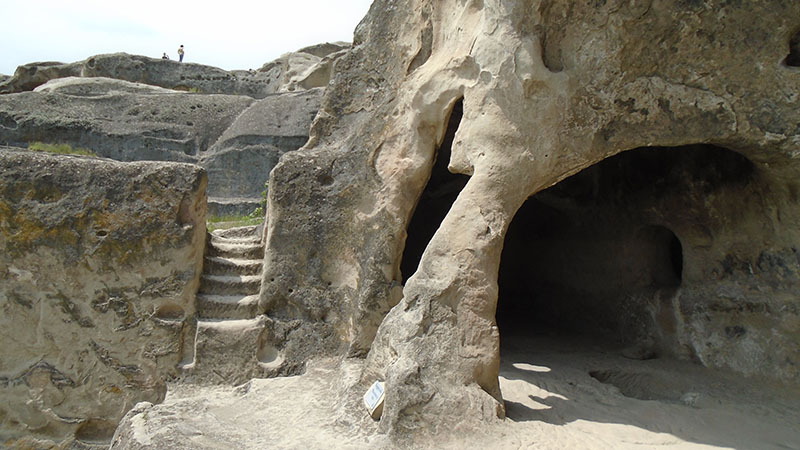Please note that the contents of this website are mine personally and do not reflect any position of the U.S. Government or the Peace Corps.
When most people think of cave cities, they probably imagine buildings inside of natural caverns or great tunnel systems carved underground, but that's not necessarily the case. On the list of awesome things about Georgia is cave cities, and we're going to look at a couple that I've visited.
Uplis-Tsikhe
There's no exact date for when Uplis-Tsikhe was founded. It is believed to have started up some time in the first millennium B.C (5th or 6th century seems to be the most common account). It grew to become a thriving trade center and crossroads linking India and China with the west. It is believed that it hit a population upwards of 20,000; though it only stretched over an area close to 22 acres in size.
You may observe two notable features. First, Uplis-Tsikhe is mostly above ground. Second, it is relatively horizontal. Uplis-Tsikhe was created by carving buildings, streets, stairs, etc. into the soft stone. It was expanded by constructing wooden buildings on and around it. The cave buildings served as palaces, churches, homes, and, perhaps most importantly, store houses. These cave buildings weren't static. As you may be able to see in the pictures, there are obviously several layers of construction corresponding to different time periods.
So why build into the stone here? It wasn't really a matter of defense. There's a natural cliff on the south side and a river. Sure, they added moats, but you can dig a moat almost anywhere. Digging into stone to create a home creates a pretty well insulated, low maintenance dwelling. This is a land with hot summers and freezing winters. The sunken dwellings provided excellent natural protection and insulation from the elements, which also aids in food storage.
Uplis-Tsikhe's ultimate demise came from multiple sources. The Mongols romped through in the 13th century. The largest blow was the decline in trade that occurred when the Byzantine Empire collapsed, but, if that wasn't enough, it was also rocked by several earthquakes. By the 15th century it was largely just used by shepherds for temporary shelter.
Uplis-Tsikhe's legacy lived on though. It was the first of the cave cities of Georgia. The techniques used there inspired the creation of multiple cave monasteries, including the largest cave city in Georgia...
Vardzia
Unlike Uplis-Tsikhe, Vardzia was built vertically. Exterior walkway connect a massive number of caves. It is believed that over 3000 caves existed in the early 13th century, but an earthquake in 1456 destroyed most. We currently know of over 550 and more are being found. There are also tunnels that go back into the cliff side to connect caves.
Vardzia is the youngest of the cave cities in Georgia and represents the greatest refinement of this sort of venture. It was founded by King Giorgi III (1156-84) as a deterent against Turkish Invasion. From some of the pictures, you may pick up that Vardzia is basically in a steep walled valley carved out by a river. Much of southern Georgia is like this. So a fortress of any sort in one of these canyons would serve as a strong deterrent, one built into the walls of the canyon would be even more difficult to take.
The role of Vardzia was expanded by King Giorgi's daughter, Queen Tamar, yes THAT Queen Tamar (if you don't know who I am talking about, stop, read this, and come back). She expanded Vardzia's role to that of a cultural center, including founding a large monastery within (which you can't enter if you are wearing shorts). This monastery is called the Church of the Assumption.
It is clear that, unlike Uplis-Tsikhe, Vardzia was designed for defense. How successful was it in that role? 400,000 soldiers from the Seljuqid Sultanate tromped into Georgia. Queen Tamar marshaled an army of only 80,000 defenders at Vardzia. Guess who won. Partly as a result of the Battle of Basiani, Vardzia became a famous stronghold of Christendom on the Islamic frontier.
Cave Cities in Games
As folks who know me or who have explored this blog can probably guess, I'm a gamer. The ideas of underground complexes and even cave cities are embedded within the very identity of the hobby. Its even in the names of some of the most venerable games: Dungeons & Dragons and Tunnels & Trolls. So I thought I'd take a moment to say a thing or two about them in that context.
As you can see, cave cities aren't necessarily the sprawling underground complexes we see in our game books or even in video games. Think about it, and start with the most basic question: Where do they get food? Then ask about waste disposal and go on to ventilation and water acquisition. At some point you might ask about the level of labor it took to build, which should remind you that cave cities are really only built into soft stone unless you are using magic of some sort.
Where you can have a giant underground complex like Derinkuyu in Turkey, more likely, you are going to have a mix of caves and surface dwellings, and you are very likely to still be surrounded by farmlands. Also, how you build your city (horizontal or vertical) will make a huge impact on its accessibility and purpose.

















































